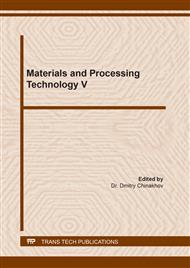[1]
Praveen, P., Yarlagadda, P.K. & Kang, M.J. (2005) Advancements in pulse gas metal arc welding, Journal of Materials Processing Technology, 164/165, 1113-1119.
DOI: 10.1016/j.jmatprotec.2005.02.100
Google Scholar
[2]
Song, Y. Yan, S., Xiao, T. (2010) A study on the macro-micro physical properties in pulsed arc plasma, Transactions of JWRI, 2, 17–18.
Google Scholar
[3]
Ravi Vishnu, P., Li, W., & Easterling, K. E. (1991) Heat flow model for pulsed welding, Materials Science and Technology, 7, 649–659.
DOI: 10.1179/mst.1991.7.7.649
Google Scholar
[4]
Karkhin, V.A., Khomich, P.N., Ossenbrink, R., Mikhailov, V.G. (2007) Calculation-experimental method for the determination of the temperature field in laser welding, Welding International, 21 (5), 387–390. doi: https://doi.org/10.1080/09507110701455574.
DOI: 10.1080/09507110701455574
Google Scholar
[5]
Karkhin, V.A. (2019). Thermal Processes in Welding. Springer, 492. doi: https://doi.org/ 10.1007/978-981-13-5965-1.
Google Scholar
[6]
Karhin V.A., Fedotov B.V., Babkin I.N., Subramaniam S. (2004) Raspredelenie temperatury i padenija naprjazhenija v vylete plavjashhegosja jelektroda pri svarke postojannym i pul'sirujushhim tokom, Svarochnoe proizvodstvo, 8, 10-20.
Google Scholar
[7]
Saraev, Yu. N., Krektuleva, R. A., & Kosyakov, V. A. (1997) Mathematical modelling technological processes of pulsed argon TIG welding, Welding International, 11(10), 807–809.
DOI: 10.1080/09507119709454429
Google Scholar
[8]
Tong, Z., Zhentai, Z., Rui, Z. (2013) A dynamic welding heat source model in pulsed current gas tungsten arc welding, Journal of Materials Processing Technology, 213, 2329-2338.
DOI: 10.1016/j.jmatprotec.2013.07.007
Google Scholar
[9]
Dragan, S.V., Yaros, Y.O., Simutienkov, I.V., Trembich, V.Y. (2015) Influence of high-frequency electrode vibrations on the geometry of penetration at automatic submerged arc cladding, Shipbuilding and Marine Infrastructure, 1, 76–86. http://smi.nuos.mk.ua/ archive /2015/1/19.pdf.
DOI: 10.15589/smi20150101
Google Scholar
[10]
Lebedev, V.A. Pichak, V.G., Smoljarko, V.B. (2001) Mehanizmy impul'snoj podachi provoloki s regulirovaniem parametrov impul'sov, Avtomaticheskaja svarka, 5, 31–37.
Google Scholar
[11]
Pulka, Ch.V., Shably, O.N., Senchishin, V.S., Sharyk, M.V. & Gordan, G.N. (2012) Influence of vibration of parts on structure and properties of metal in surfacing, The Paton Welding Journal, 1, 23-25.
Google Scholar
[12]
Goloborod'ko A.Zh., Dragan S.V., Simutenkov I.V. (2013) Avtomaticheskaja naplavka pod fljusom konstrukcionnyh stalej s poperechnymi vysokochastotnymi peremeshhenijam, Avtomaticheskaja svarka, 6, 35-38.
Google Scholar
[13]
Karunakaran, N. (2013) Effect of Pulsed Current on Temperature Distribution and Characteristics of GTA Welded Magnesium Alloy, IOSR-JMCE, 4(6), 01-08.
DOI: 10.9790/1684-0460108
Google Scholar
[14]
Lebedev V.A., Solomichuk T.G., Novykov S.V. (2019) Study of a Welding Harmonic Oscillation influence on the Welded Metal Hardness and Weld Bead Width, Journal of Еngineering Sciences, 6, 16–21.
Google Scholar
[15]
Ivanov, V., Lavrova, E., Burlaka, V. & Duhanets, V. (2019) Calculation of the penetration zone geometric parameters at surfacing with a strip electrode, Eastern-European Journal of Enterprise Technologies, 6/5(102), 57-62.
DOI: 10.15587/1729-4061.2019.187718
Google Scholar
[16]
Ivanov, V., Lavrova, E., Morgay, F. & Semkiv, O. (2021) Investigation of the heat-affected zone properties during cladding of power equipment with austenitic materials using control mechanical impacts on the strip electrode, Materials Science Forum, 1038, 100-107. https://doi.org/10.4028/www.scientific.net/MSF.1038.100.
DOI: 10.4028/www.scientific.net/msf.1038.100
Google Scholar
[17]
Ivanov, V., Lavrova, E., Kibish, V., & Mamontov, I. (2021) Research of the microstructure of the deposited layer during electric arc surfacing with control impacts, Materials Science Forum, 1038, 85-92. https://doi.org/10.4028/www.scientific.net/MSF.1038.85.
DOI: 10.4028/www.scientific.net/msf.1038.85
Google Scholar
[18]
Serenko, A. N., Shaferovsky, V. A., & Pivtorak, N. I. (1993). Temperature fields in two-arc welding with programmed conditions, Welding International, 7(10), 802–804.
DOI: 10.1080/09507119309548495
Google Scholar
[19]
Belousov, Yu. V., Leshchinsky, L. K., & Sologub, B. B. (1976). Selection of optimum shape of strip electrode for wide-layer deposit, Automatic Welding, (12), 24–28.
Google Scholar
[20]
Matvienko, V., Mazur, V., Leshchinsky, L. (2015). Evaluation of shape and sizes of weld pool in surfacing using combined strip electrode, The Paton Welding Journal, 9, 28 – 31.
DOI: 10.15407/tpwj2015.09.04
Google Scholar


